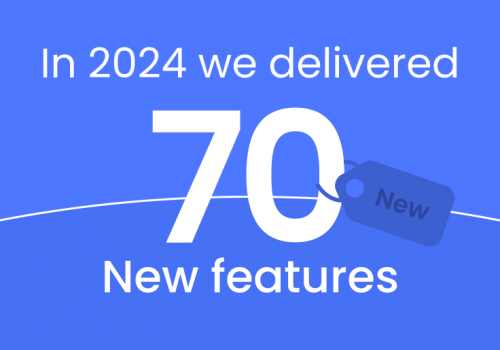Lead Scoring Strategies. It’s just turned 2021, and many people around the world are getting started on their goals for the new year. The same is true for businesses. The new year is a great time to evaluate what you want to achieve by this time next year and whether you could be doing something different to help get you there. With this in mind, we thought it would be a great idea to look at lead scoring. Lead scoring is traditionally seen as a B2B practice, but not anymore.
What is Lead Scoring?
Lead scoring is the process of ranking your leads based on various factors, usually revolving around how valuable they are to your organization. Companies take part in lead scoring because it helps identify the leads that are most likely to convert into paying customers. Or, in other words, the leads that deserve your attention the most.
Lead scoring is popular in B2B companies for several reasons. In a B2B environment, people often take much longer to decide on a purchase. This is because the investment is usually more expensive, will impact the day to day working of employees, and the decision-maker may be held responsible if the product ends up being a bad fit for the business. Due to the longer sales process, it’s also easier to track leads through the sales funnel more precisely. Sales reps will often get detailed feedback on the leads’ thoughts and feelings concerning the product or service as they progress through the funnel.
Lead scoring aims to move the leads with the most converting potential through the funnel to the marketing qualified lead (MQL) or sales qualified lead (SQL) stage and close them.
So, what about B2C lead scoring? Can it work for customer-facing retail businesses too? It sure can. The principle is much the same – you assign a numeric value to your customer’s actions and then craft experiences that will increase their probability of converting into paying customers.
While B2B companies focus on firmographic data of their leads like company size, annual revenue, number of employees, lead rank within the organization, these are largely irrelevant for B2C companies. Instead, B2C companies need to focus on customer demographics.
Now you’re all caught up on what lead scoring is and how it functions differently in a B2C environment, let’s look at some expert lead scoring tips for B2C companies in 2021.
9 Lead Scoring Tips for B2C Retail Companies in 2021

1. Make a List of All Digital Activities
The first thing you need to do when setting out on your lead scoring journey is to make a list of all digital activities that users take part in. For example:
- Email subscriptions
- Email engagement – Whether users open emails, click on links within emails, or whether they unsubscribe from the mailing list.
- Page visits
- Live chat interactions.
- Social media interactions.
- Free trial sign-ups.
These are all activities that show the user’s level of interest in your product or service.
2. Segment Your Customers
Since B2C lead scoring is all about demographics, it’s vital that you start to look at your customers in relation to their segments. It’s 2021, and if you’re not already collecting this data, then you should be. The key demographics you should pay attention to are location, income, age, and gender. Have a look at the data you have already and see whether you can find any patterns. Do people in the age range 30-45 tend to click on emails more than other age groups? What about social media? Many companies find that people in younger age ranges of 18-24 or 24-30 tend to make up the majority of social media interactions.
It’s vital that you establish these segments because it will help you craft your sales funnel campaigns. You can create campaigns that resonate better with certain age groups. For example, for users who tend to interact on social media, you might want to focus on getting your message across in short and snappy videos.
3. Setting Your Scores
Leading scoring wouldn’t be lead scoring without assigning points. Once you’ve established what digital activities your users take part in, the next step is to assign scores. There’s no gold standard on how to do this, so you can develop your own point scoring system that works for your company. With that said, here’s an example of how to do it.
Let’s say a user visits your website where you sell high-end sportswear. We’ll call this user Mike. Mike visits your website and searches for a specific brand of wetsuit. This action is promising – it shows that Mike is at least somewhat interested in buying a product from you, and he knows what he wants. The item Mike is looking for is out of stock, but he joins the email list to be notified of when the product is back in stock. This action is very promising. The sales process could have broken down before this for several reasons:
- Mike didn’t find the wetsuit he wanted.
- The price wasn’t what he was expecting.
- He needs it urgently and isn’t willing to wait for it.
- He doesn’t need it urgently, but he’d rather look elsewhere for somewhere that does have it in stock so he can complete the buying process in one sitting.
- He’d like that specific brand of wetsuit, but it’s not essential to him, and he’s happy to go with a different brand of equal quality or price.
Mike’s first action, signing up for the email notification, generates some lead scoring points. Let’s say in this scenario, we assign Mike 7 points for this action. This action kickstarts his buyer journey, and you can engage him in an automated email campaign. For example, you might send him an email a few days later with examples of other similar wetsuits that match his first option’s quality or price range.
Mike opens one of these emails. If he does this, then you can assign him another 4 points (he’s showing more intent to buy). If he clicks on a link within the email, you can assign him 5 more points.
At this point, Mike has clocked up a total of 16 points. At this point, he might only be a few points away from meeting the threshold. If he revisits the website in a few days (3 points) or opens another email (4 points), he will reach your threshold of 20 points.
When a prospect reaches the 20-point threshold, he’s now an MQL, and it’s time for the sales team to get involved. A sales rep can be assigned to Mike and reach out to him directly via email to either schedule sometimes to talk, make an offer, or encourage further contact.
4. Automate Your Scoring System
All lead scoring systems should be automated for maximum ease and efficiency and to reduce the probability of errors. You can create automated user IDs and assign points in a database or spreadsheet, allowing them to accumulate until they reach the threshold. Once the threshold has been met, the user is automatically sent through the sales team, complete with a list of actions they have taken and the score they reached.
5. Set Your Threshold
Setting the threshold is perhaps the trickiest part of the whole process because there are so many things to consider.
If you place your threshold too low, then several things can happen:
- The sales team becomes overwhelmed because a high number of prospects continually meet the threshold and need to be contacted.
- It doesn’t work – Having a lead scoring process is only marginally better than not having one at all because your MQL or SQL requirements are too low. You start contacting people who have a low potential to convert into paying customers.
- Customers become frustrated with the increased contact, and you get a reputation for being spammy, pushy, or aggressive in your sales practices. This can erode trust in your brand.
Equally, if you set your threshold too high, you risk missing out on many potential sales because you didn’t reach out and nurture them.

6. Experiment with Thresholds
Your threshold doesn’t have to be set in stone. It’s recommended that you revisit your threshold regularly (every six months or every year) and determine whether it needs to be lowered or increased. Try to resist the urge to make significant changes in your threshold. You’ll likely find you’ll have more success by decreasing or increasing it by only a few points. After you’ve made a change, remember to pay attention to the numbers. Track how many leads you convert before and after the change to see whether it’s made a positive or negative impact.
It would help if you also tried to minimize other changes you make at the same time. If you change your threshold at the same time that you revamp your email campaign or overhaul your website, you won’t know whether your threshold change or the need facelift is responsible for the change in numbers.
7. Reduced Lead Scoring
So far, we’ve discussed the actions that can add to the lead score, but you can also factor in attributes that decrease the lead score to get a more accurate depiction of prospect intent. Here are some activities that you sign assign negative or low scores to:
- Poor demographic fit: If the user falls far outside of your ideal buyer persona, you might want to assign a negative score. Your email campaigns will likely not be tailored towards this type of buyer and your potential to convert them is low. Examples of this could be users from locations you can’t deliver to or who don’t speak the same language as your sales staff.
- Individual pages: It’s a good idea to assign different scores for different pages on your website. Your home page will have a lower score than other pages because all users see this page, and therefore it doesn’t say anything about intent. However, if the user clicks on the About Us, Contact, or Product page, this shows more intent and should be assigned a higher score.
- Unsubscribing from the email list: Either the buyer is no longer interested in your product at all, or they’re uncomfortable with the level of contact.
8. No Impact Activities
You might decide not to assign any score at all from some activities. For example, while it is common to assign a score for opening emails, some companies choose not to do this. Why? Because high email open rates could be a sign of excellent email titles rather than buyer intent.
9. Understanding the Purpose of Lead Scoring
Many people go into this process, misunderstanding what they should be aiming for with the lead scoring process. The goal isn’t to push more leads through to the sales team or even to push leads through the sales funnel faster. The ultimate goal is to help the sales team prioritize, which leads to focus on – the ones with the highest converting potential.




















